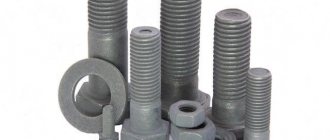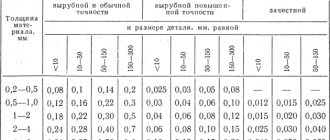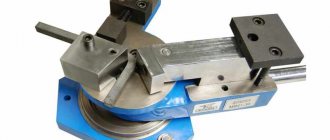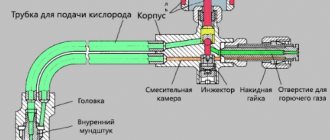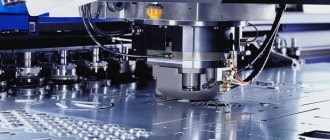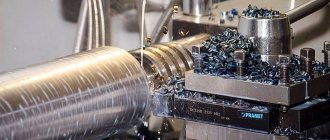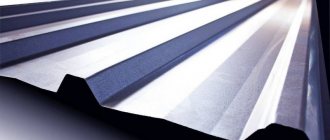By casting or pressure (pressing, stamping, etc.)
Note: If the marking or stamp can be applied in any way, then the method of application is not indicated.
4. Designations and methods of applying markings and stamps are indicated on the inclined section of the leader line.
AN EXAMPLE OF APPLYING on a drawing the designations of the serial number of a product by impact and the mark of final acceptance with paint, if all the data on marking and stamping are available in the technical specifications for the product, is shown in the drawing. 1 .
In this case, in the technical requirements of the drawing, an entry is made like: “3. Mark and brand according to specifications. "
AN EXAMPLE OF APPLYING on a drawing a designation of a material grade - with paint, a product designation, its serial number and a trademark - using the foundry method, if it is necessary to indicate on the drawing data about the location, method of application and font of the marking that is not in the technical specifications, is shown in Fig. 2.
In this case, in the technical requirements of the drawing, an entry is made according to the type:
a) if the markings are made in different fonts, -
"4. Mark according to specifications. font GOST. "
5. Mark according to specifications. Chl - in font. GOST. Nl - in font. GOST "
"6. Mark according to specifications. font GOST. ":
b) if the markings are made in the same font, -
"4. Mark according to specifications. font GOST. "
(Introduced additionally, Amendment No. 1).
TERMS AND DEFINITIONS
Marking is the application of marks on a product that characterize this product.
Marking is a set of signs that characterize a product, for example: designation, code, batch (series) number, serial number, date of manufacture, trademark of the manufacturer, grade of material, selectivity group, installation or transport marks, etc.
Branding is the application of marks to a product that certify its quality.
A stamp is a sign certifying the quality of a product.
MARKING
IPC PUBLISHING HOUSE OF STANDARDS Moscow
INTERSTATE STANDARD
MECHANICAL ENGINEERING AND INSTRUMENT ENGINEERING PRODUCTS
Marking
Machine building and instrument making products.
MKC 01.080.30 OKSTU 4108, 4109
By Decree of the USSR State Committee on Standards dated February 18, 1986 No. 366, the implementation date was set as 01/01/87
This standard applies to the marking of mechanical and instrument engineering products (hereinafter referred to as products), applied directly or in the form of applied elements to products of all climatic versions in accordance with GOST 15150-69.
The standard establishes technical requirements for marking and methods for quality control of marking.
This standard establishes requirements for products manufactured for the needs of the national economy and export.
DEFINITIONS, CLASSIFICATION
1.1. Marking - trademarks, symbols, inscriptions and images applied to the product and providing passport, warning, instructional and other brief information about the product and its manufacturer, as well as data necessary for the installation and operation of the product.
1.2. Trademarks are designations registered in accordance with the established procedure that serve to distinguish the goods of one enterprise from similar goods of other enterprises. Trademarks can be verbal, figurative, three-dimensional, combined and others. A trademark must be originally designed and have an identifying, representative and advertising character. Registration of trademarks in the USSR and abroad is carried out in the manner established by the USSR State Committee for Inventions and Discoveries.
Technique for applying impact-dot markings
The technology involves applying any signs, lines and patterns using the needle impact method, with surface deformation - this determines the wear resistance and durability of the applied information.
Today the market offers a wide variety of special equipment for applying dot-impact markings using special needles made of high-strength alloys (most often tungsten-carbide).
The movement of the head with the needle enclosed in it is carried out by a pneumatic or electromagnetic drive. High-frequency vibrations of the needle knock out dots on the surface in the desired sequence, ultimately forming an inscription, straight lines or a design. The width of the lines is from 0.1 to 0.5 mm, and even up to 1 mm.
The devices allow you to program the future drawing or inscription, select the depth and width of the lines.
Thanks to modern equipment, dot-impact marking can be applied not only to perfectly flat, even surfaces - but also, for example, to rounded ones or those with a curvature of up to 5-7 mm.
Modern equipment for needle-impact marking may have additional rotation axes that can hold parts up to 200 kg or more, special heads and guide needles for applying symbols in hard-to-reach areas of the product.
For accuracy, the position of the needle when drawing characters, as well as the depth of the lines, is computer programmed. The equipment is controlled using a working console and a visualizing monitor.
The devices can be in the form of one solid block - or consist of two separate blocks. Some equipment can be directly connected to a computer, which significantly expands the possibilities for programming and design of future markings.
The speed of marking devices can vary - up to 8-16 characters per second. Impact-type markers can be stationary for conveyors, tabletop or portable hand-held. Many portable devices do not require constant connection to a 220V network, since they can function for some time by charging the built-in batteries.
Appendix 1 (recommended). DESIGNATIONS OF CONTENTS AND METHODS OF APPLYING MARKINGS AND STAMPS
DESIGNATIONS OF CONTENTS AND METHODS OF APPLYING MARKINGS AND STAMPS
1. The contents of the marking are indicated by the letter designations given in Table 1.
Trademark, name of the manufacturer
Product designation according to the main design document
Product serial number*
Heat number, serial number in the heat
Signs of polarity, direction of rotation, direction of fluid flow, etc. data necessary for installation
________________ * The product number also refers to the batch or series number.
2. The contents of the mark are indicated by the letter designations given in Table 2.
Tests (control): mechanical, hydraulic, pneumatic, electrical, hardness, etc.
3. Methods of applying markings or brands are indicated by the letter designations given in Table 3.
Method of applying markings or stamps
By casting or pressure (pressing, stamping, etc.)
Note. If a marking or stamp can be applied in any way, then the method of application is not indicated.
4. Designations and methods of applying markings and stamps are indicated on the inclined section of the leader line.
AN EXAMPLE OF APPLYING on a drawing the designations of the serial number of a product by impact and the mark of final acceptance with paint, if all the data on marking and stamping are available in the technical specifications for the product, is shown in Drawing 1.
In this case, in the technical requirements of the drawing, an entry is made like: “3. Mark and brand according to specifications. ".
AN EXAMPLE OF APPLYING on a drawing a designation of a material grade - with paint, a product designation, its serial number and a trademark - using the foundry method, if it is necessary to indicate in the drawing data on the location, method of application and font of the marking that is not in the technical specifications, is shown in Figure 2.
In this case, in the technical requirements of the drawing, an entry is made according to the type:
a) if the markings are made in different fonts, -
"4. Mark according to specifications. font GOST. ".
"5. Mark according to specifications. Chl - in font. GOST. Nl - in font. GOST. ".
"6. Mark according to specifications. font GOST. ":
b) if the markings are made in the same font, -
"4. Mark according to specifications. font GOST. ".
APPENDIX 1. (Introduced additionally, Amendment No. 1).
Technologies and methods of data application
There are 2 application methods - direct and additional. In the case of the latter, the information is placed on a tag, label, sticker or some other item that is attached to the product. This method is not popular in the metallurgical industry because tags and labels can easily come off or get mixed up during transportation.
The main method of application is direct. That is, placement directly on the product. Let's consider several technologies for such marking.
1. Thermal transfer printing. For this method, special thermal transfer tapes are used, the paint layer from which is transferred to the metal under the influence of high temperature. The method is not very popular due to the large amount of consumables and lower marking reliability compared to other technologies.
2. Impact-point. Using a needle-impact printer, a large number of dots are printed on the surface of the product. This method easily applies both alphanumeric information and 2D barcodes, which are later read using a DPM code scanner.
Such marking is very popular among many manufacturers, since it does not require a large amount of consumables (the service life of one tungsten-carbide punch is several million blows) and is very wear-resistant. A paint layer is even applied over the markings without compromising the readability of the information.
Read also: Primer on a chainsaw, what is it?
3. Electrochemical. Data is applied on a stencil under the influence of an electric current charge. As a result of the reaction, the color or even the surface topography changes, forming the necessary letters and numbers.
4. Stamping (branding). It is carried out using a pre-made stamp on a mechanical press, which makes an impression with the necessary information. The standard set of stamps includes letters and numbers. From a technological point of view, this is the most cost-effective and simplest method.
5. Drop jet. Contactless method of applying data. It is often used in cases where the product is small in size and other data application technologies can deform it. Information is applied with drops of ink.
6. Drawing. It is carried out using a needle pressed tightly to the surface of the metal, which draws grooves on its surface. The technology is used as an alternative to dot-impact marking. The needle deforms the surface to a lesser extent and produces noticeably less noise during operation.
Appendix 2 (for reference). TERMS AND DEFINITIONS
Marking
- application to the product of signs characterizing this product.
Marking
- a set of signs characterizing the product, for example: designation, code, batch (series) number, serial number, date of manufacture, trademark of the manufacturer, grade of material, selectivity group, installation or transport marks, etc.
Branding
— applying marks to the product certifying its quality.
Brand
- a sign certifying the quality of the product.
Advantages of dot impact marking
• High speed of application of symbols or designs on surfaces.
• No special surface preparation is required - markings can even be applied to, for example, painted, damp or dusty products.
• There is no need for other consumables such as paints.
• Equipment for applying needle-impact markings has a relatively low cost.
• Wide range of applications.
• Durability and high ISO resistance of markings, capable of remaining in their original form even under very aggressive operating conditions. The service life of dot-impact markings is directly proportional to the service life of the product itself on which it is applied.
• Application of any symbols, logos, profile drawings, lines, letters.
• The devices can be programmed both for applying text in GOST fonts and for inscriptions in non-standard types of fonts.
• Marking can be applied to any metals, steels, alloys - and even hardened steel (hardness - up to 70 HRC *).
• The surface with such markings can be covered with paints or varnish - the information will be visible.
• No chemical solutions or caustic materials are used for marking - therefore, there are no strict requirements for the room where this equipment is installed.
Are there any disadvantages to this type of marking?
There are disadvantages, but they are closely related to the advantages, and they cannot be considered disadvantages in all circumstances:
• It is impossible to make changes to the marking that has already been applied - it will not be erased. A surface that has already been marked cannot be returned to its original form.
• Wood, glass and other fragile surfaces, and paper are not marked.
Metal marking methods
Currently, any part, assembly, tool or equipment undergoes mandatory marking or, in other words, the application of a number of symbols with which it can be identified.
There are several most common methods of applying inscriptions:
- Branding is carried out using a stamp under pressure on a mechanical press; thanks to a pre-prepared stamp with a mirror image of the symbols, a direct image is applied to the surface. Most often used for marking non-ferrous metals and steel parts;
More information about impact marking devices
- Electrochemical - widely used in the automotive and aviation industries, is economical and is used for marking metal of any degree of hardness;
- Thermal transfer printing, transfer of designation from a special coloring material to a thermal transfer label;
- Drop jet - used for marking parts and assemblies directly on the conveyor;
- Laser - fast and high-quality burning of marks on the metal surface using a fiber-optic laser; this method is used to mark locking equipment;
More information about laser marking machines
- Punch-dot - by applying dots using a series of blows, the required inscription is formed. The entire process is controlled by numerical control. This method is effective for marking products made of plastic materials and hardened metals;
More information about impact marking devices
- Engraving - Using a carbide needle, the machine engraves the part. The only disadvantage of this method is that marking is impossible for hard alloys
More information about devices for drawing
- Labeling with tags - used for gluing, hanging or screwing tags containing a description and barcode of the product onto products
